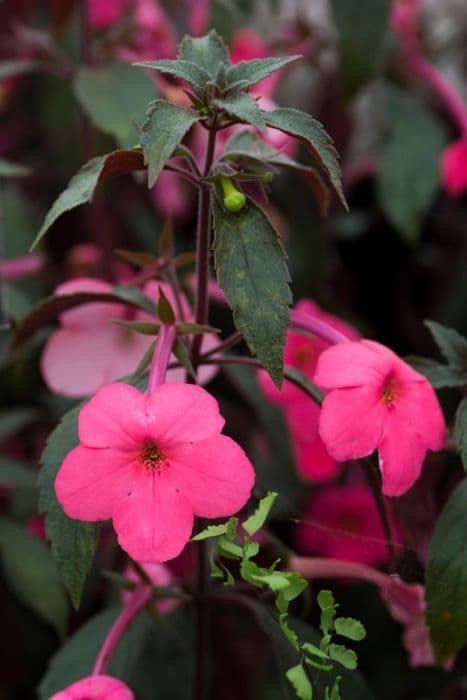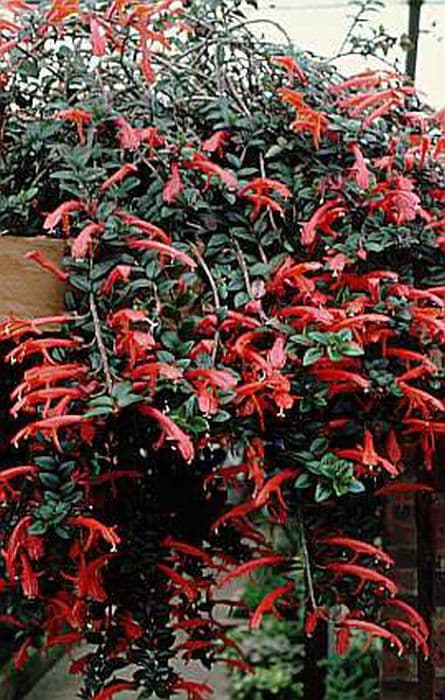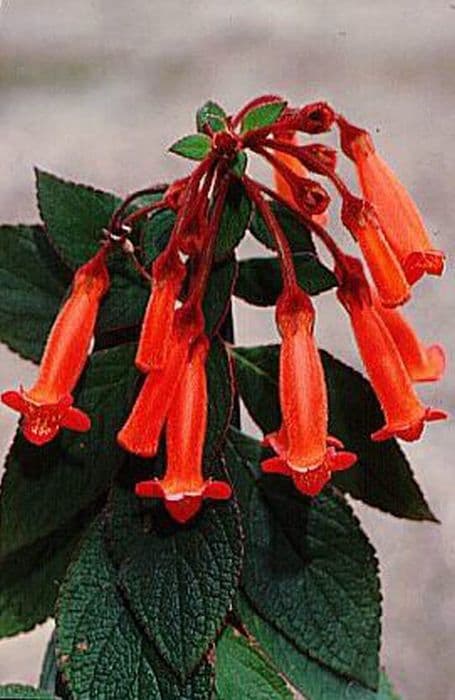Cape Primrose Streptocarpus 'Jessica'

ABOUT
Streptocarpus 'Jessica', commonly known as Cape Primrose, displays a visually appealing and vibrant appearance. The plant bears lush, velvety leaves that typically have a deep green color and may exhibit a slight rosette formation, creating a dense and soft foliage base. From this base emerge delicate and slender flowering stalks, which support the plant's standout feature: its blossoms. The flowers of Cape Primrose 'Jessica' are particularly ornate, with a trumpet-like shape that is both elegant and eye-catching. The petals usually come in a rich shade of purple or violet, though they may also display a gradient of hues, with lighter tones near the throat transitioning into bolder colors towards the edges. It’s common for throats of the flowers to be accented with contrasting yellow or white markings, adding a further layer of intricacy to their presentation. The blooms are typically arranged in loose clusters, giving the impression of a relaxed yet abundant floral display. Each flower is designed to attract attention, making the Cape Primrose 'Jessica' a favorite among enthusiasts for its ornamental qualities. Despite prohibitions on discussing size, it's clear that the visual impact of the plant is not dependent on its dimensions, but rather on the lushness of its foliage and the striking appeal of its blossoms.
About this plant
 Names
NamesFamily
Gesneriaceae
Synonyms
Cape Primrose, African Violet Cousin
Common names
Streptocarpus 'Jessica'
 Toxicity
ToxicityTo humans
Cape primrose, including the Streptocarpus 'Jessica', is generally considered non-toxic to humans. There are no well-documented cases of poisoning from ingesting the plant, so it's unlikely to cause harm if accidentally consumed in small amounts. However, it is always advisable to keep plants out of the reach of small children who might chew on them, as individual sensitivity can vary and plants not typically considered toxic can sometimes cause mild stomach upset if ingested.
To pets
Cape primrose, such as the Streptocarpus 'Jessica', is not known to be toxic to pets. It is considered pet-friendly and there should be no symptoms of poisoning in pets if they ingest parts of the plant. Nevertheless, it's good practice to prevent pets from eating plants as a general precaution, because they could potentially cause gastrointestinal upset or an unexpected allergic reaction.
 Characteristics
CharacteristicsLife cycle
Perennials
Foliage type
Evergreen
Color of leaves
Green
Flower color
Varies
Height
1 foot (30 cm)
Spread
1 foot (30 cm)
Plant type
Herb
Hardiness zones
10
Native area
Tanzania
Benefits
 General Benefits
General Benefits- Easy to Care For: Cape Primrose, including the 'Jessica' variety, generally requires minimal maintenance, suitable for novice gardeners.
- Aesthetic Appeal: With its vibrant flowers and attractive foliage, this plant adds color and beauty to indoor spaces.
- Long Blooming Period: Cape Primrose is known for its lengthy flowering season, providing enjoyment for much of the year.
- Variety of Colors: The 'Jessica' variety, as with many Streptocarpus, comes in a range of colors, offering versatility in home decor.
- Compact Size: Being a small to medium-sized plant, it is ideal for windowsills and limited space areas.
- Propagation Ease: Cape Primrose can be easily propagated from leaf cuttings, making it simple to expand your collection or share with others.
- Non-Toxic: Streptocarpus 'Jessica' is not known to be toxic, making it safer for homes with pets and children.
 Medical Properties
Medical PropertiesThis plant is not used for medical purposes.
 Air-purifying Qualities
Air-purifying QualitiesThis plant is not specifically known for air purifying qualities.
 Other Uses
Other Uses- Artistic inspiration: Cape primrose's vibrant blooms and unique foliage can serve as a beautiful subject for paintings, drawings, and photography, capturing the essence of the flower in various forms of art.
- Educational tool: Botany students can study the Cape primrose to learn about plant growth habits, propagation, and the diversity of the Gesneriaceae family.
- Floral arrangements: Although not traditionally used for cut flowers, Cape primrose can be incorporated into small, water-containing floral arrangements for short-term display.
- Craft projects: Pressed flowers from the Cape primrose can be used in scrapbooking, card making, or other craft projects for decoration.
- Garden photography backdrop: The lush foliage and striking flowers of the Cape primrose can provide an attractive backdrop for photographing other garden plants or wildlife.
- Plant competitions: Enthusiasts can grow Cape primrose to enter into horticultural shows and competitions, showcasing their skill in cultivating this particular species.
- Bee and butterfly attractor: While outdoors, Cape primrose can attract pollinators such as bees and butterflies, helping to support local ecosystems.
- Color therapy: The vibrant colors of the Cape primrose flowers can be used in color therapy for their calming and uplifting effects on the mind and spirit.
- Theme gardens: Those creating a specific garden theme, such as a fairytale or Victorian garden, may incorporate Cape primrose for its old-world charm and vivid colors.
- Teaching plant structure: The clear and distinct structure of the Cape primrose makes it a useful example when teaching about plant parts, such as leaves, stems, and flowers.
Interesting Facts
 Feng Shui
Feng ShuiThe Cape Primrose is not used in Feng Shui practice.
 Zodiac Sign Compitability
Zodiac Sign CompitabilityThe Cape Primrose is not used in astrology practice.
 Plant Symbolism
Plant Symbolism- Resilience: Streptocarpus, commonly known as Cape Primrose, often symbolizes resilience because it can thrive with minimal care and bounce back from neglect.
- Endurance: The ability of Cape Primrose to adapt to various light conditions and its long blooming period represent endurance, overcoming challenges over time.
- Hope: With its bright flowers and persistent nature, Cape Primrose can signify hope, suggesting a positive outlook and expectations for the future.
 Water
WaterCape primrose, commonly known as Streptocarpus 'Jessica', should be watered when the top inch of soil feels dry to the touch. Depending on the humidity and temperature of the environment, this might range from once a week to every other week. Use room temperature water and gently pour it onto the soil until you see water draining from the bottom of the pot—this ensures the root system is thoroughly moistened. It's important not to let the plant sit in standing water, so empty the saucer shortly after watering. The amount often works out to about 8-16 ounces of water for a 6-inch pot, each watering session.
 Light
LightCape primrose requires bright indirect light to thrive best. Place the plant in a spot where it can receive filtered sunlight, such as near an east or north-facing window. Direct afternoon sunlight should be avoided as it can scorch the leaves. If natural light is insufficient, consider using a grow light for part of the day to supplement.
 Temperature
TemperatureThe Cape primrose prefers cooler temperatures and does well in a range with a minimum of 50 degrees Fahrenheit and a maximum of 75 degrees Fahrenheit. The ideal temperature for this plant is between 60 and 70 degrees Fahrenheit. Be cautious of placing it near drafts, heating vents, or air conditioners as extreme temperature shifts can stress the plant.
 Pruning
PruningThe Cape primrose benefits from regular pruning to remove faded flowers and yellowing leaves, which encourages new growth and prolongs blooming. Pruning is best done after a flowering cycle ends. Deadheading, or the removal of spent flowers, can be performed as needed throughout the bloom period to keep the plant tidy and may stimulate further blooming.
 Cleaning
CleaningAs needed
 Soil
SoilThe best soil mix for Cape Primrose (Streptocarpus 'Jessica') is light and well-draining, consisting of 2 parts peat moss or coco coir, 1 part perlite or vermiculite, and 1 part fine bark or compost to add a bit of structure and nutrients. The soil pH should ideally be slightly acidic to neutral, ranging from 6.0 to 7.0.
 Repotting
RepottingCape Primrose should be repotted every year or whenever it outgrows its current container. The best time to repot this plant is in spring or summer, which allows for active growth following the repotting process.
 Humidity & Misting
Humidity & MistingCape Primrose thrives best in moderate to high humidity levels, ideally between 50% to 60%. It is important to maintain these humidity levels for the plant's optimal health and to promote lush foliage and vibrant blooms.
 Suitable locations
Suitable locationsIndoor
Place in bright, indirect light; keep compost moist.
Outdoor
Sheltered spot, dappled shade; protect from frost.
Hardiness zone
10-11 USDA
 Life cycle
Life cycleThe life of Streptocarpus 'Jessica', commonly known as Cape Primrose, begins with seed germination, typically in a moist, well-draining medium with temperatures around 70°F. Upon sprouting, seedlings develop their first set of true leaves and enter the vegetative growth stage, where they focus on leaf expansion and root development. During this period, the plant requires bright, indirect light and consistent moisture. Cape Primrose will then transition to the flowering stage when mature enough, producing velvety flowers in a variety of colors depending on the cultivar, often for an extended period if properly cared for with reduced feeding in winter. After the flowering stage, if flowers are pollinated, seed pods may form, elongating into twisted shapes (hence 'Streptocarpus' meaning 'twisted fruit'), containing numerous tiny seeds that can be collected for propagation. The plant can live for many years as a perennial in suitable conditions, with each rosette lasting several years before dying back, while new rosettes develop to continue the cycle.
 Propogation
PropogationPropogation time
Spring to Summer
Streptocarpus 'Jessica', commonly known as Cape Primrose, can be propagated by leaf cuttings, a popular method for its ease and effectiveness. The best time to propagate is during the plant's active growth period, generally in the spring or early summer. To propagate using a leaf cutting, select a healthy, mature leaf and cut it across into pieces about 1 to 2 inches (approximately 2.5 to 5 centimeters) long, ensuring each piece has a vein. Lay the cuttings on the surface of a well-draining potting mix and slightly press them into the soil. The leaf pieces should be kept moist and in a warm, bright environment, but out of direct sunlight. In a few weeks, new plants will begin to form at the base of the cuttings. These can be potted individually once they have grown large enough to handle.









